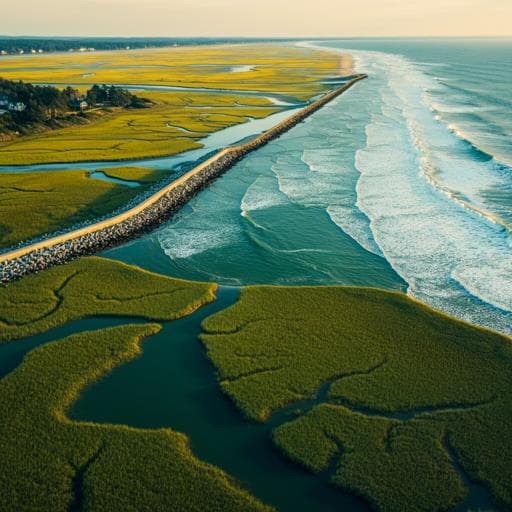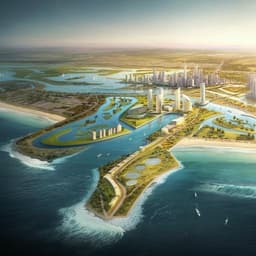
Engineering and Technology
Marsh restoration in front of seawalls is an economically justified nature-based solution for coastal protection
E. I. H. Lee and H. Nepf
Explore the groundbreaking research by Ernie I. H. Lee and Heidi Nepf, which unveils the economic advantages of marsh restoration in coastal areas. Their study demonstrates how nature-based solutions can effectively protect coastlines, offering insights into wave dynamics and cost-benefit analyses.
~3 min • Beginner • English
Introduction
Coastal storms threaten hundreds of millions of people, disrupt transportation networks, and cause billions of dollars in damages annually, with losses expected to grow under sea-level rise and intensifying storms driven by climate change. Traditional gray infrastructure, such as concrete seawalls, is costly to construct and maintain and reflects, rather than dissipates, wave energy, potentially exacerbating erosion elsewhere. In contrast, natural shorelines (marshes, mangroves, seagrass, kelp, coral and oyster reefs, sandy beaches) attenuate wave energy, adapt dynamically to sea-level rise, enhance erosion resilience, and provide ecosystem services. This study addresses how to quantify the coastal protection benefits of marshes placed in front of seawalls within an economic framework. The research question is whether restoring or maintaining a marsh in front of an existing seawall can provide sufficient wave attenuation to reduce overtopping and required seawall height, such that the combined system is economically justified compared to seawall heightening alone. The work integrates a physics-based wave attenuation model that accounts for vegetation morphology and flexibility with a benefit–cost analysis to value avoided seawall heightening and ecosystem services, and applies it to a real-world site at Juniper Cove, MA.
Literature Review
Prior field and laboratory research has shown that salt marshes attenuate waves and reduce storm surge and erosion. Many models represent vegetation effects via empirical drag coefficients calibrated to site-specific conditions, which limits predictability across sites and seasons because plant morphology and flexibility vary. Hybrid defenses that combine gray and green elements can reduce wave loads and deliver co-benefits. Economic evaluations have indicated potential cost-effectiveness of nature-based solutions, but systematic approaches to quantifying ecosystem services and avoided infrastructure costs remain under development. This study builds on prior work by using a first-principles vegetation reconfiguration framework to predict drag based on species-specific morphology and stiffness, integrating it into a 1-D wave model, and coupling results to overtopping and economic analyses.
Methodology
Wave attenuation modeling: A one-dimensional, cross-shore wave model propagates linear waves from offshore to a vertical seawall. Wave amplitude evolves stepwise due to four processes: (1) vegetation drag (computed mechanistically from plant morphology and structural stiffness, accounting for reconfiguration via wave Cauchy number and length ratio for stems and leaves), (2) shoaling via group velocity changes, (3) depth-induced breaking using Miche’s criterion and dissipation scaled by breaking probability, and (4) bed friction using standard roughness-based formulations. Species-specific inputs include stem/leaf geometry, Young’s modulus, bending stiffness, shoot density, and number of leaves per stem. The model outputs wave height at the seawall toe for given offshore wave conditions, bathymetry, and marsh width/structure. Overtopping estimation: Wave height at the wall is mapped to mean overtopping rate using EurOtop (2018) empirical relations as a function of freeboard. The coastal protection benefit of marshes is expressed as the reduced freeboard (avoided seawall heightening) needed to achieve a target overtopping rate compared to the no-vegetation case. Benefit–cost analysis (BCA): Benefits include (i) avoided seawall heightening (capital cost savings) and (ii) annual ecosystem services per unit marsh area. Costs include (i) marsh plantings (plugs), (ii) marsh creation/stabilization (earthworks), (iii) engineering/management/contingency, and (iv) annual maintenance. Monetary values are compiled from literature and adjusted to 2023 USD using CWCCIS indices. Capital items are annualized over a 50-year service life using a selected discount rate; recurring items remain annual. The benefit–cost ratio (BCR) is the ratio of total annualized benefits to costs. Sensitivity analyses: The study evaluates sensitivity to (a) water depth at wall toe and offshore wave height (including storm-breaking-limited H0 = 0.88 h1), (b) vegetation species and seasonal condition (healthy vs dormant), (c) marsh width (0–100 m), and (d) discount rate (0–11%). Model validation: The wave model is validated against field data from two Netherlands marshes (Bath with Scirpus maritimus; Hellegat with Spartina anglica) using reported morphology and rigidity; number of leaves per stem is bracketed to reflect winter conditions. Case study: The Columbus Avenue Seawall (Juniper Cove, Salem, MA) is analyzed with a 1-D approach along 10 transects between a breakwater and a curved seawall section (~79 m). SWAN outputs at the breakwater for 10-, 50-, 100-year storms provide boundary conditions. Site-specific planting zones are assigned to Spartina alterniflora and Spartina patens based on elevation ranges. Project life is 50 years; marsh assumed fully established.
Key Findings
- Model validation: Without calibration, predicted and measured wave heights agreed well at Bath (R² = 0.88–0.90) and Hellegat (R² = 0.71–0.92).
- Even modest marsh widths can matter: At Hellegat, a 55 m marsh produced 32% greater wave height reduction than a non-vegetated foreshore of the same bathymetry.
- Dominant dissipation mechanism shifts: Without vegetation, depth-induced breaking dominated energy loss; with vegetation, drag on plants dominated and breaking diminished to levels comparable to bed friction.
- Species matter: Wave attenuation varied by about a factor of two across species; stiffer stems/leaves (higher E·I) yielded greater attenuation. Phragmites australis provided the greatest attenuation; Scirpus mariqueter the least.
- Seasonality matters: Healthy (in-season) plants provided 8–17% more attenuation than dormant (winter) plants in generic tests; in the Juniper Cove case study, healthy plants yielded 16–50% more attenuation than dormant plants, consistent with prior reports of 15–30% seasonal differences.
- Economic performance (generic analyses): Using conservative (low) unit benefits/costs, BCR was predominantly >1 across a wide range of marsh widths and conditions, indicating economic justification. BCR decreases with increasing marsh width due to diminishing marginal wave attenuation (and hence diminishing avoided heightening) per added meter of marsh.
- Sensitivity to hydrodynamics: Wave attenuation and BCR are more sensitive to water depth at the seawall toe than to offshore wave height. Greater depth reduces vegetation influence (smaller canopy fraction of water column), increasing wave height at the wall and reducing avoided freeboard and BCR.
- Storm-height sensitivity: For storm conditions with offshore wave height set by the breaking limit (H0 = 0.88 h1), larger H0 increases energy and thus potential avoided-height benefits, elevating BCR vs the base H0 = 1.5 m cases.
- Discount rate sensitivity: BCR declines with higher discount rates, as environmental services (annual benefits) are discounted more heavily than one-time capital costs; sensitivity is strongest at low discount rates.
- Contribution of benefits: Environmental services can exceed 50% of total monetized benefits, but their valuation range (low vs high) introduces uncertainty in BCR.
- Case study (Juniper Cove): Healthy-vegetation cases met EurOtop pedestrian safety overtopping criteria for 10- and 50-year storms along most transects, whereas dormant/no-vegetation cases generally did not. The additional seawall height needed in the no-vegetation scenario to match vegetated overtopping was governed by the most critical transect: 1.7 m (10-year, Transect 10), 1.3 m (50-year, Transect 6), and 1.1 m (100-year, Transect 6). Dormant-vegetation BCR fell below 1.0 for discount rates ≥6%.
Discussion
The study shows that a physics-based wave attenuation model that explicitly accounts for plant morphology and stiffness can reliably predict wave damping by marshes across sites and seasons, overcoming the limited transferability of calibrated drag-coefficient approaches. Vegetation-induced drag reduces the likelihood and intensity of wave breaking near structures, offering secondary benefits such as reduced sediment resuspension and potential reductions in toe scour and associated maintenance. Integrating overtopping predictions with a benefit–cost framework quantifies the coastal protection value of marshes as avoided seawall heightening, alongside ecosystem service values. Sensitivity analyses reveal that water depth at the seawall toe is a key driver of both physical and economic performance; deeper water reduces vegetation’s relative influence and compresses avoided-height benefits. Offshore wave height influences BCR as well, particularly under storm-breaking limits, but the overall sensitivity is less than that to depth. Species selection and seasonal condition materially affect performance; stiffer, taller plants (e.g., Phragmites australis) can maximize attenuation, though ecological considerations may guide against invasive species. The discount rate strongly affects BCR outcomes by down-weighting long-term ecosystem services; policy choices on discount rates therefore critically influence the apparent economic desirability of nature-based solutions. Environmental services can represent a major share of benefits, underscoring the need for robust, standardized valuation methods.
Conclusion
This work advances coastal protection planning by (1) introducing and validating a 1-D wave model that predicts vegetation-induced wave attenuation from first principles using species-specific morphology and stiffness; (2) coupling wave predictions with overtopping estimates to quantify avoided seawall heightening; and (3) embedding these physical outcomes within a benefit–cost analysis that includes ecosystem services. Across generic scenarios and a real-world case study (Juniper Cove, MA), marsh-fronted seawalls generally achieve BCR > 1, even for relatively narrow marshes typical of constrained urban settings, indicating economic justification as a hybrid nature-based solution. The analysis highlights the strong influence of water depth, species/seasonality, and discount rate on outcomes, and shows environmental services can account for more than half of total benefits. Future work should: develop standardized, site-specific ecosystem service valuation methods; improve efficient, accurate mapping of vegetation traits (species, height, density) via remote sensing; incorporate erosion/toe-scour reduction benefits into economic analyses; and account for dynamic marsh response under sea-level rise, including sediment accretion and accommodation space for landward migration.
Limitations
- Erosion/scour reduction benefits were not quantified for the BCA due to lack of established methods, potentially underestimating total benefits.
- Vegetation trait data collection is labor-intensive; while remote sensing offers promise, current methods face challenges (ground-truthing, canopy occlusion, equipment and computational costs).
- The wave model is 1-D, assumes linear waves and shore-normal propagation; alongshore variability and complex bathymetry/structure interactions are simplified.
- Model runs assumed fully established marsh; establishment timelines and early-stage performance were not evaluated.
- Stem breakage under extreme storms was not explicitly modeled in results, though the framework allows representing breakage empirically.
- Economic outcomes are sensitive to site-specific unit costs (seawall construction varies by up to a factor of ~20 between low/high estimates), environmental service valuations, and chosen discount rate.
- Practical minimum marsh width and habitat requirements constrain designs; diminishing marginal wave damping with width competes with ecosystem service gains.
Related Publications
Explore these studies to deepen your understanding of the subject.







